How to Draw Tall Pine Trees
Pine trees are evergreen coniferous trees that are native to most countries in the Northern Hemisphere. Pine trees belong to the family Pinaceae and the genus Pinus. It is estimated that there are over 126 species of pine trees in the world. Pines are resinous trees that are related to other types of conifers such as fir trees, cedars, and spruces.
Different types of pine trees grow in many different environments that include cold regions in North America, rain forests, and hot sandy deserts. Pine trees are also an important source of wood because they grow fast and are tall, straight trees. Even though pine wood is a type of softwood, many species are hard and strong enough to use in construction.
Wood from pine trees is used to make furniture, flooring, construction frames, and timber. Pine wood is also an important source of pulp to make paper.
In this article, you will learn about the various types of pine trees. As well as their scientific name, descriptions of pines and pictures of pine trees will help you identify them.
Pine Tree Identification
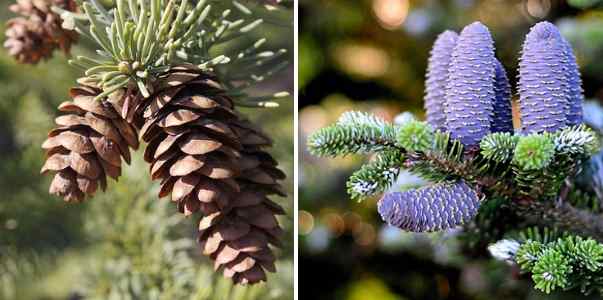
Pine tree cones usually grow downwards (left picture) whereas those of fir trees (right picture) grow upwards
Pine trees can be identified by their needle-like leaves, seed-bearing cones, and reddish-brown or gray bark. Another identifying feature of pine trees is their egg-shaped cones that hang down from branches. Some types of pines can have large woody cones with scales that are long and straight. These cones open to release seed or pollen and then fall off.
One of the ways to tell pine trees apart from fir trees is by the way their needles and cones grow. Pine needles grow in clusters on the twigs while fir needles are softer and are attached singularly to the branch. Pine cones hang down whereas fir tree cones tend to grow straight upward from the branches.
Pine Tree Identification by Needles
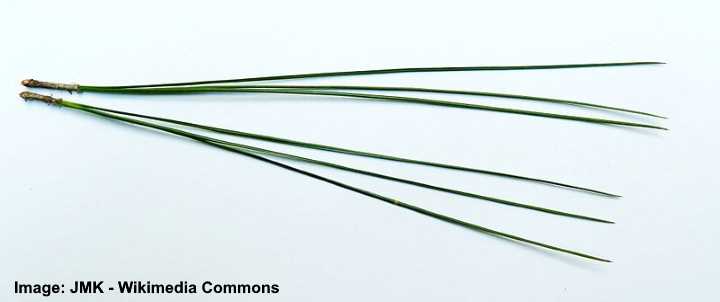
Two fascicles of a loblolly pine. Each fascicle has three needles.
Pine needles are the easiest way to identify pine trees. Unlike other coniferous trees with needle-like leaves, pine tree needles grow in small bundles called fascicles. Each fascicle on pine trees contains two, three, or five needles. Some pine trees are identified by having seven needles in a bundle.
Species of pines—white, red, and yellow—are identified by the number of needles in a bundle. For example, like most white pines, the eastern white pine tree is classed as a five-needle pine because it has five needles in each bundle. However, two-needle pine species tend to be red pines, and yellow pines are three-needle pine trees.
Pine trees can also be identified by their needles as the length of pine needles can vary widely. Longleaf pine (pinus palustris) has the longest pine needles measuring 18" (45 cm) long. Foxtail pine (pinus balfouriana) has the shortest pine needles measuring 1" (2.5 cm) long.
Soft Needled Pines vs. Hard Needled Pines
An identifying feature of pine trees is whether the needles are soft or hard. Soft needled pines usually have fascicles with five needles, whereas hard needled pines have two or three needles per bundle.
Soft needled pines
Pine trees in the subgroup of "soft pines" tend to be white pine trees with five needles per bundle. Varieties of soft-needled pines include the western white pine (Pinus monticola), the eastern white pine (Pinus strobus), the limber pine (Pinus flexilis), and the Japanese white pine (Pinus parviflora).
Hard needled pines
Varieties of hard pine trees include species of red pine trees and yellow pine trees. Common species of hard needled pines include the ponderosa pine (Pinus ponderosa), jack pine (Pinus banksiana), red pine (Pinus resinosa), and the lodgepole pine (Pinus contorta).
Types of Pine Trees (With Pictures and Names) – Identification Guide
Let's look in more detail at some of the most common species of pine trees in the world.
Eastern White Pine Tree (Pinus strobus)
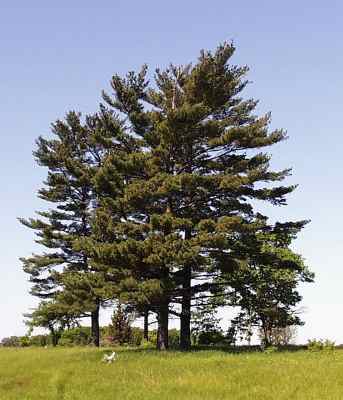
The eastern white pine is a soft five-needled pine that is also a popular type of Christmas tree
The eastern white pine has soft needles that grow in clusters of five and have a bluish-green appearance. On mature trees, the bark is rough and gray in color. Even though this is a huge type of tree, you can prune it to create a landscaping pine tree bush.
The eastern white pine cones are long, slender and usually slightly curved, growing to 6" (16 cm). The white pine cones have thin scales that whiten at the apex.
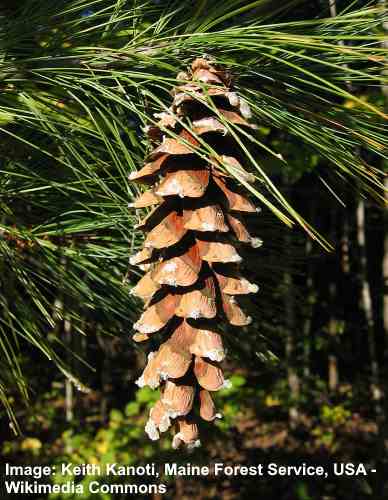
Pinus strobus cone
Eastern pines also grow well in containers and are a popular type of Christmas tree. The species has good needle retention after being cut and they emit a pleasant citrusy scent.
The eastern white pine is one of the most important pine species in North America. These are fast-growing trees and one of the tallest species of pines.
Pine tree identification
Eastern white pines are a tall species and grow to up to 230 ft. (70 m) high. Eastern white pine cones are long and slender, growing to 6" (16 cm) long. The eastern white pine has soft needles that grow in clusters of 5.
Western White Pine Tree (Pinus monticola)
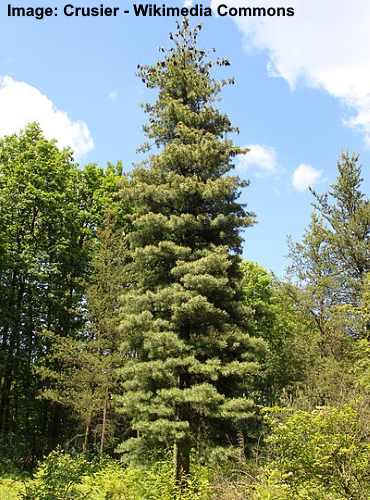
Western white pine tree is a soft five-needle pine with a pyramidal shape
The western white pine is a huge native pine. The western white pine is identified by its soft needles growing in bundles of five, pyramidal growth habit, and reddish-brown bark. The large pine tree grows 100 to 164 ft. (30 – 50 m) tall and is common in the northwestern United States.
Other identifying features of the western white pine are its long, slender pine cones measuring up to 12" (30 cm) long, finely serrated needles growing 2" to 5" (5 – 13 cm) long, and a relatively narrow, conical appearance.

Pinus monticola cones
The western white pine also goes by other names like the Californian mountain pine and the silver pine. The majestic white pine is also called the Idaho pine as it's the state tree of Idaho.
Eastern pine vs. western pine
The five-needled eastern white pine (Pinus strobus) and western white pine (Pinus monticola) are closely related.
The differences between the western and eastern white pine are the cones and needles. The western white pine has longer cones, and its needles have more prominent stomatal bands. Another difference is that the western white pine has a slenderer appearance than the eastern white pine.
Pine tree identification
The western white pine is identified as a tall, pyramidal pine tree with a slender conical shape, long, soft pine needles in bundles of five, and long slender greenish-brown pine cones measuring up to 1 ft. (30 cm) long.
Sugar Pine Tree (Pinus lambertiana)

The sugar pine is the tallest of the pine trees
Also called the sugar cone pine, this massive tree is the tallest species of pine in the world. Sugar pines also have the longest cones of any tree in the Pinaceae family. This pine species gets its common name from the sweet resin in the tree.
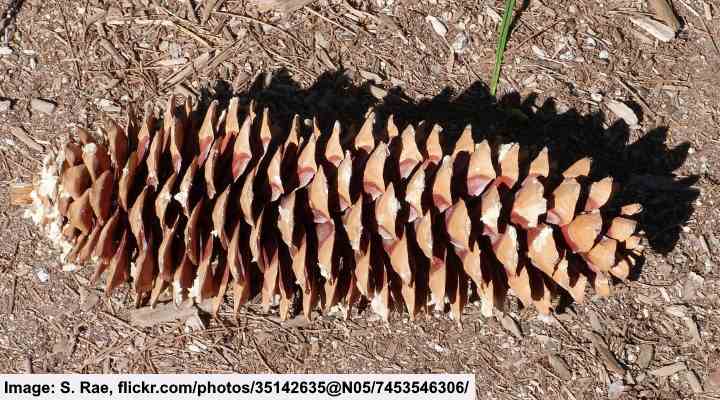
Pinus lambertiana cone
Sugar pine has long needles that are light green in color and have white lines running their length. Close up, you will see that the bark is reddish-brown with pronounced furrows.
Pine tree identification
Being the tallest of the pine trees, the subgenus lambertiana grows up to 270 ft. (82 m). However, their average size is between 130 and 195 ft. (40 – 60 m). Slender pine needles grow in bundles of 5 and can measure up to 4.14" (14 cm) long. The long woody dark brown cones can grow up to 20" (50 cm) long.
Red Pine Tree (Pinus resinosa)
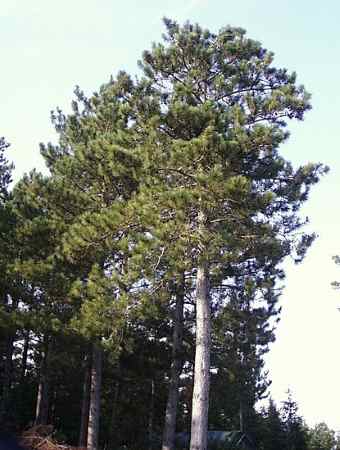
The red pine has two needles per fascicle and it has reddish bark on the upper part of the tree
The red pine is an evergreen conifer that is characterized by a tall straight trunk, conical shape, and egg-shaped cones. Red pine tree has 2 needles per fascicle and the yellow-green needles are long, brittle and snap easily.
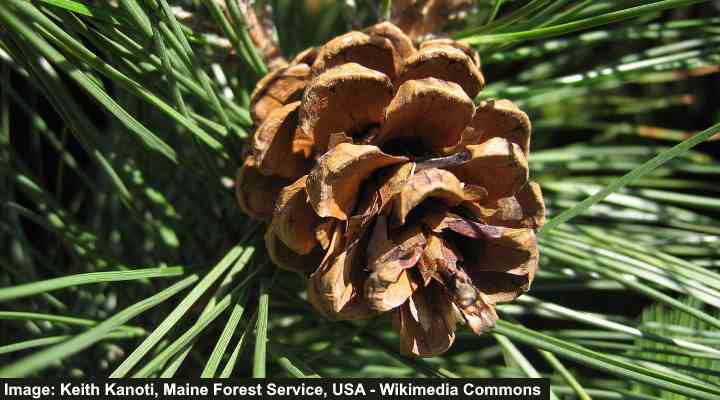
Pinus resinosa cone
The red pine gets its name from the red-orange bark that grows on the upper part of the tree.
Looking at pictures of mature red pines, you will notice that the crown is dome-shaped.
Pine tree identification
The red pine tree is a medium-sized pine tree that grows to between 66 and 115 ft. (20 -35 m). Red pine identification is by the needle-like leaves that grow in clusters of 2 and are yellow-green in color.
Gray Pine Tree (Pinus sabiniana)
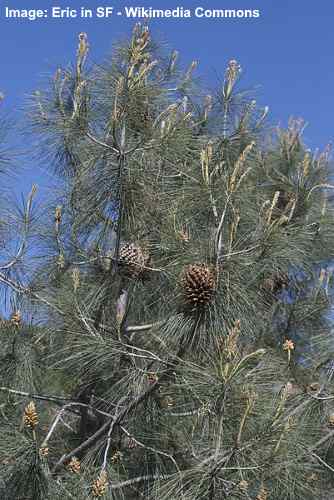
The Gray Pine has gray-colored needles that grow in clusters of three and it has very large cones
The gray pine tree is a native conifer to North America and is characterized by its conical crown, sparse foliage, egg-shaped brown cones, and long gray-green needles. The three-needled gray pine has needles growing 8" to 12" (20 – 30 cm) long. And a unique feature of the gray pine tree is its heavy, barrel-like cones that can weigh up to 1.5 lbs. (0.7 kg).
The gray pine tree is a relatively short pine species growing 36 to 45 ft. (11 – 14 m) tall. The drought-tolerant pine adapts well to desert conditions and grows well in most soil types. Additionally, the tree has a slightly weeping appearance due to the sparse, drooping needles growing on wiry branches.
Pine tree identification
The gray pine tree has easily identifiable features that include sizable rounded pine cones, long pale grayish-green needles in fascicles of three, sparse leaf growth, and a conic crown that leans to one side.
Pitch Pine Tree (Pinus rigida)
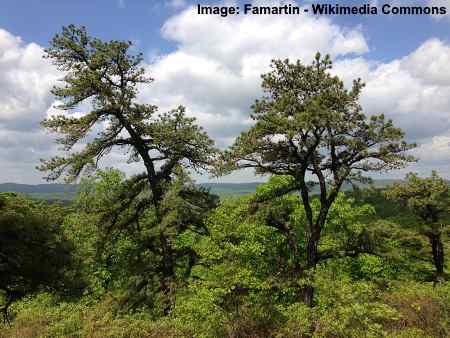
Pitch pine tree is identified by its twisted branches
One of the distinguishing features of the pitch pine is its irregular shape and twisted branches. Its common name comes from the fact that its sticky resin was used for pitch in shipbuilding and railroad ties.
The long needles of the pitch pine tree give its branches a somewhat spiky look. Although pitch pines are a hardy conifer that grows in difficult environments, it is not an important timber tree. Mostly, pitch pines are used for pulp or constructing pallets.
Because of its uneven growing patterns, pitch pines are a favorite type of miniature tree among bonsai enthusiasts.
Pine tree identification
Pitch pines are small to medium-sized trees that reach modest heights of between 20 and 98 ft. (6 – 30 m). Needles are long and stout and grow in bundles of three. Cones are long, oval, and prickly and grow up to 2.34" (7 cm).
Scots (Scotch) Pine Tree (Pinus sylvestris)
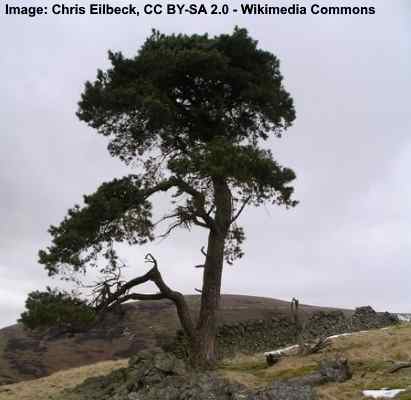
Scots (Scotch) pines have bluish-green short needles
Scots (Scotch) pine trees are stunning evergreen conifers that have thick scaly brown bark, bluish-green needles, and small red to tan cones. Scots pines generally have a forked trunk that gives the medium-sized pine 2 flat masses of foliage.
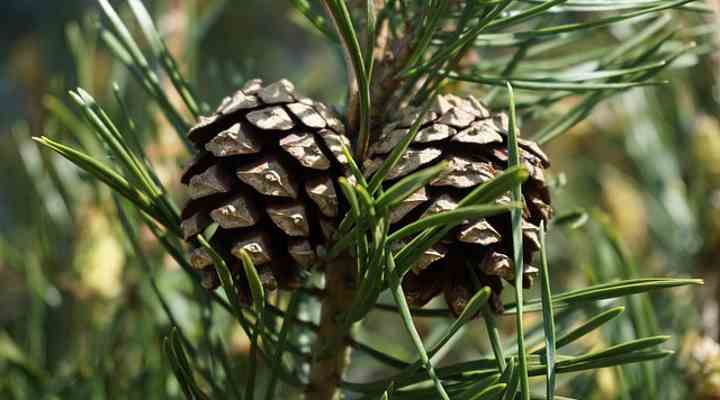
Pinus sylvestris cones
Scots (Scotch) pines are also popular natural Christmas trees as they don't shed their needles easily. Dwarf varieties of evergreen pines are also grown for their ornamental value in landscaped gardens.
Pine tree identification
Scots pine trees grow to around 114 ft. (35 m) tall with some varieties reaching 148 ft. (45 m). The trees are identified by their short needles that grow in bundles of 2, but sometimes 3 or 4.
Jack Pine Tree (Pinus banksiana)
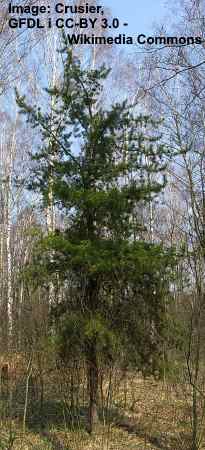
Jack pines are small evergreen trees with small cones
Jack pines, similar to pitch pines, have an irregular shape, dark green needle foliage, and grow in poor soil conditions.
One of the identifying features of Jack pines is their small yellowish prickly cones that are curved at their tip. These cones open in heat or if there is a fire. The gray bark is rough and fissured.
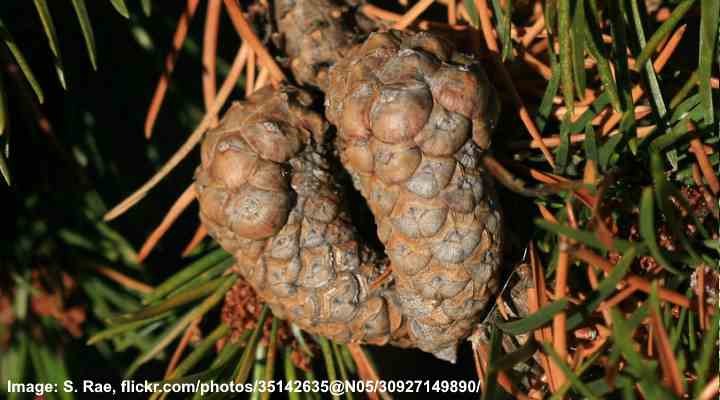
Pinus banksiana cones
Pine tree identification
Jack pines are small evergreen pines with some varieties not growing more than a shrub. Jack pines can range in size from 30 to 72 ft. (9 – 22 m). Their yellowish-green needles are twisted and only about 1.5" (4 cm) long.
Longleaf Pine (Pinus palustris)
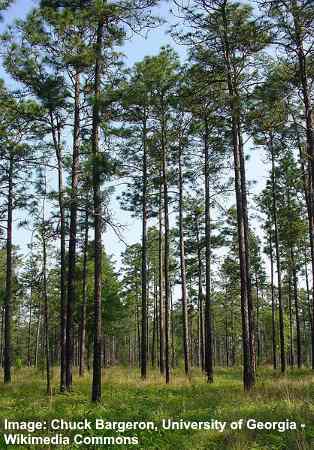
Longleaf pines have long needles and trunks
As its name suggests, the longleaf pine is an evergreen conifer that produces long dark green needles. This species of pine is also important in the timber and pulp industry due to its long straight trunk. Longleaf pines are also classed together with shortleaf pine as they are both types of southern yellow pines.
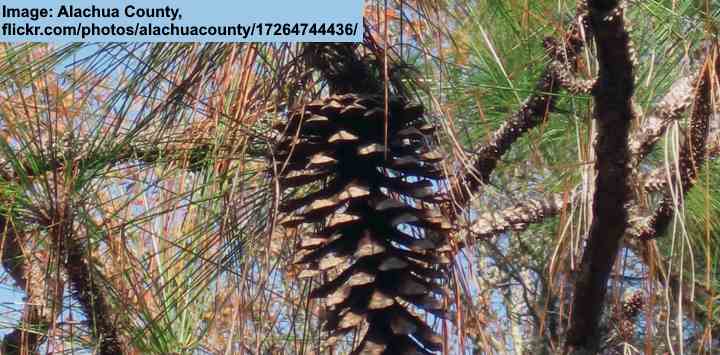
Pinus palustris cone
As with many tall pine trees, most of the foliage grows at the top of the tree. Dead branches fall off as the tree grows and eventually reaches about 100 ft. (30 m) in height.
Cones from the longleaf pine species measure about 6" to 10" (15 – 25 cm) long and are reddish-brown.
Pine tree identification
Longleaf pines grow to between 100 and 115 ft. (30 – 35 m) with the tallest being 154 ft. (47 m). These evergreen conifers are identified by their tall slender trunks and large hard cones. Longleaf pines produce long needle-like leaves that grow to between 8" and 18" (20 – 45 cm).
Shortleaf Pine (Pinus echinata)
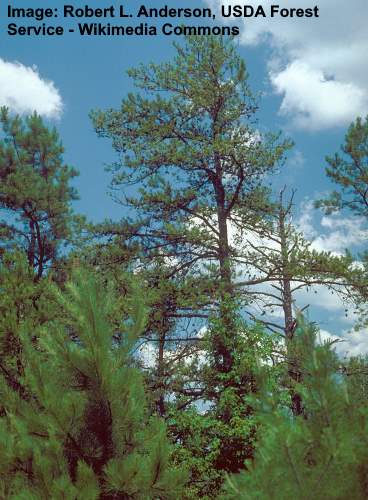
Shortleaf pines have shorter needles and smaller cones than longleaf pines
The shortleaf pine is a type of yellow pine tree similar to the longleaf pine, only with shorter needle leaves. Similar to the longleaf variety, these southern pines are an important species in the timber industry.
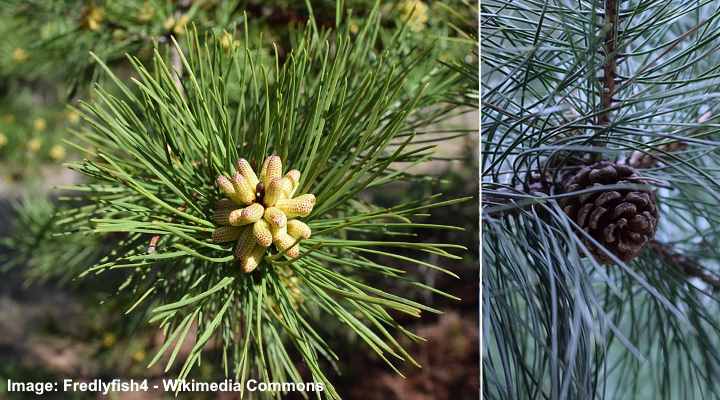
Pinus echinata male and female cones
Shortleaf pines are distinguished from their longleaf cousins by their needles, bark, and cones. Needles grow to about 5" (12 cm) and they have tiny cones compared to the longleaf pines. These small reddish-brown cones may only measure 2" (5 cm) long. You can also tell the species apart with the dark bark in rectangular shapes on the shortleaf species.
Pine tree identification
These pine trees from the Pinus echinata species grow to between 65 and 100 ft. (20 – 30 m).
Bristlecone Pine (Pinus aristata)
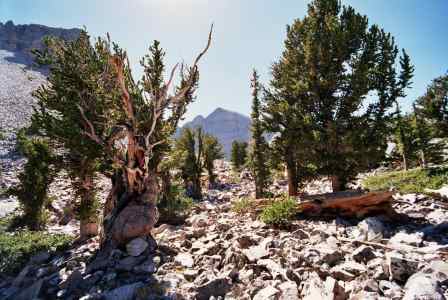
Bristlecone pine is a type of small pine tree
The bristlecone pine is a small pine tree with grayish-brown bark, short needle-covered branches, and yellow-tan cones in the shape of an egg.
Bristlecone pines are versatile trees that grow in a range of climates. They are common in high altitudes in the cold Rocky Mountains and also grow in the hot Arizona desert.
Bristlecone pine needle color tends to be dark green to a green with a blue tinge. Immature cones are a deep purple color and gradually turn yellow or beige.
Pine tree identification
Species of bristlecone pines grow to between 8 and 20 ft. (2 – 6 m). Leaves are needle-like and are 1.5" (4 cm) long and have a bluish-green color.
Loblolly pine (Pinus taeda)
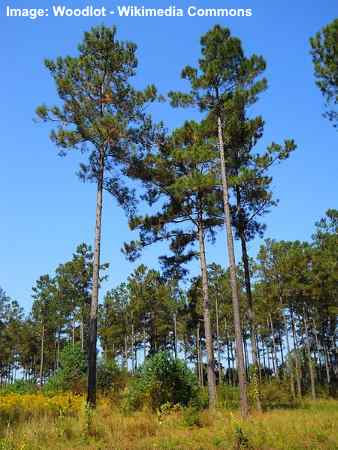
The tall Loblolly pines are very common in south-east USA
Loblolly pines are classified with southern yellow pines and are one of the most common trees in the U.S. These pines in the lower classification of Pinus australis are tall, elegant trees with a crown of green foliage at the top of their 115-ft. (35-m) trunks.
Loblolly pines are common in the southeastern regions of the US and they grow in swampy, acidic soil. These are also a resinous pine that is prized for its high-quality softwood timber.
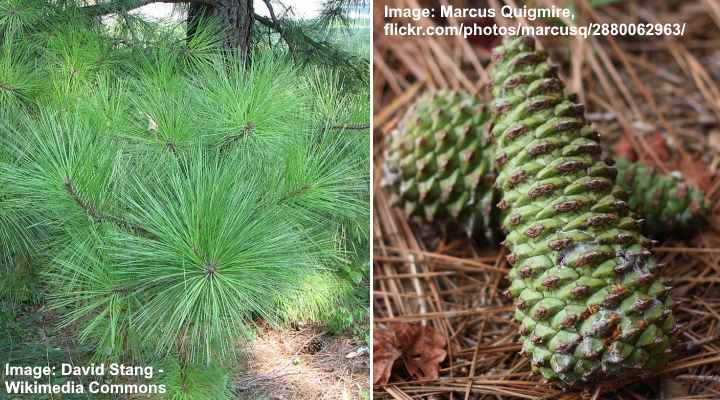
Pinus taeda needles and cones
Loblolly pine cones are identified as reddish-brown and have a narrow, conical shape. The pointed, egg-shaped pine cones have sharply spined scales that open wide in dry weather.
Pine tree identification
The majestic Loblolly pines grow to between 100 and 110 ft. (30 – 35 m) high and they have wide trunks up to 5 ft. (1.5 m) in diameter. Their dark green needles are about 8" (20 cm) long and grow in bundles of three.
Slash pine (Pinus elliottii)

Slash pine has long needles and is native to southeastern USA
This resinous conifer tree in the genus Pinus is a fast-growing pine that has wide, spreading foliage. Characteristics of the slash pine are long slender needles, glossy red-colored cones, and orange bark.
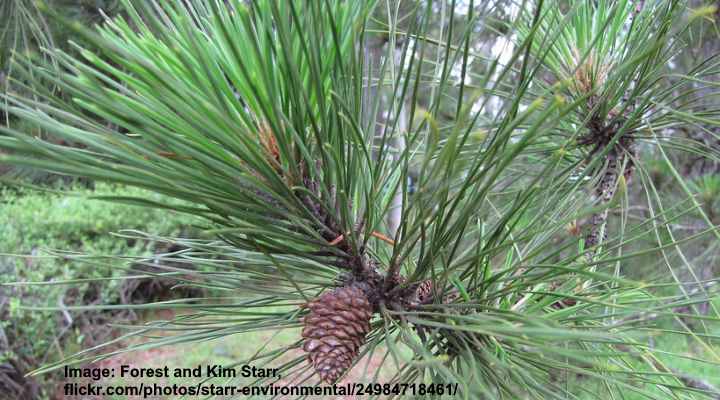
Pinus elliottii needles and cones
This pine tree species is also classed along with the yellow pines. It is another important pine tree in the timber industry. These pines can also create pine hybrids with other species that are common in the southern states of the U.S. such as the longleaf pine and loblolly pine.
Pine tree identification
Slash pines grow to between 60 and 100 ft. (18 – 30 m). Needles grow in clusters of 2 or 3 and can be as long as 10" (24 cm).
Virginia pine (Pinus virginiana)
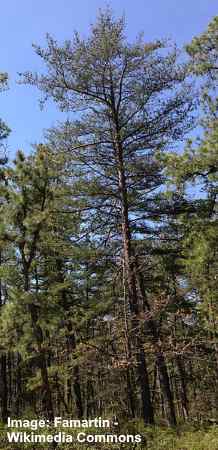
Virginia pine has short needles that are quite sharp
The Virginia pine is a medium-sized species of pine tree with short pine needles and large seed cones. During the summer, the needle foliage is deep green and this turns yellow-gold in winter.
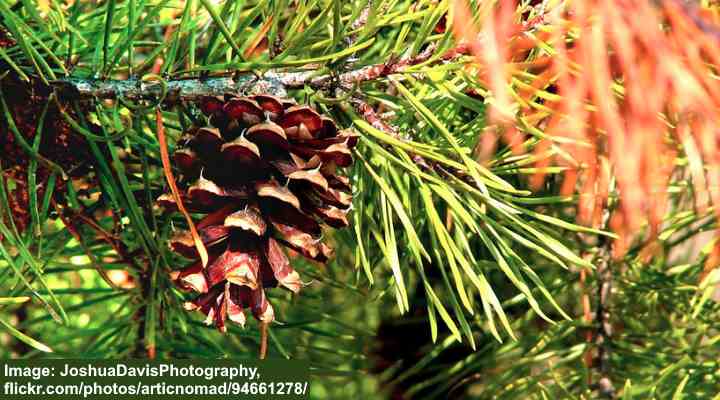
Pinus virginiana needles and cones
The needles on Virginia pines are not soft and are quite sharp to touch. Despite this fact, small varieties of Virginia pines are also popular Christmas trees. They have red and brown bark that has a rough texture.
Pine tree identification
Virginia pines grow to between 18 and 60 ft. (9 – 18 m). Their needle-like leaves are just 0.78" to 3.14" (2 – 8 cm) in length and they grow in 2 needles per cluster.
Lodgepole pine (Pinus contorta)
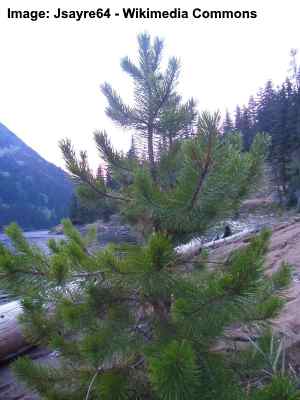
In the picture: a young lodgepole pine tree
The lodgepole pine tree can grow as a short evergreen shrub or tall slender pine tree, depending on the subspecies. The taller varieties are some of the largest pine species that grow in the U.S. Lodgepole pines generally grow at high altitudes in coastal or cold mountainous areas.
One of the identifying features of lodgepole pines is their conical shape. Branches grow outwards and upwards and get shorter nearer the top. The dark green foliage turns bright yellowish-green in the wintertime.
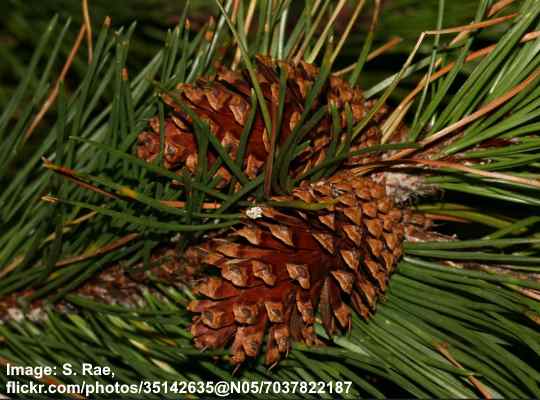
Pinus contorta needles and cones
Lodgepole pine needles are glossy and dark green. The needles grow in pairs and some varieties of pine can have up to 5 needles in a cluster. Cones are light brown and approximately 1" – 3" (3 – 7 cm) long.
Pine tree identification
Lodgepoles are narrow pines that grow to between 130 to 160 ft. (40 – 50 m) high. The pine tree foliage is characterized by short shoots and pointed needles that are 1.5" to 3" (4 – 8 cm) long.
Ponderosa pine (Pinus ponderosa)

The tall Ponderosa pine is important in the timber industry
The ponderosa pine tree is a huge evergreen conifer with unique orange-red bark and black markings. Due to its extremely long and straight trunk, this pine species is prized in the timber industry. It is also called the bull pine, western yellow pine, or blackjack pine.
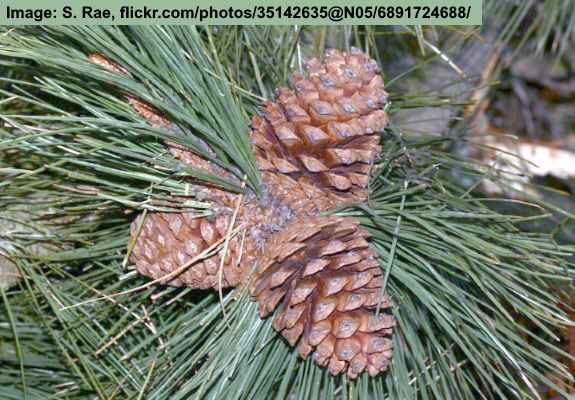
Pinus ponderosa needles and cones
Ponderosa pine trees can be identified by their long, straight trunk and their long slender needles. The cones can be dark purple to red-brown, depending on the exact subspecies. Cones measure between 2" to 4" (5 – 10 cm) in length.
Pine tree identification
Ponderosa pines are classified as a big tree species and grow up to 235 ft. (72 m) tall. The green flexible needles grow to around 8" (20 cm) and they have 3 in each bundle growing on the shoots.
Coulter Pine (Pinus coulteri)
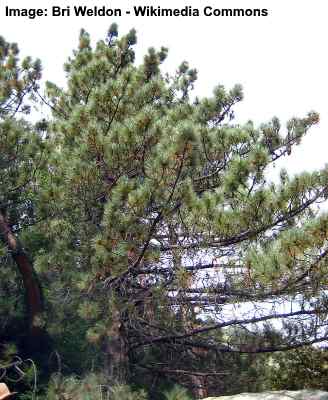
Coulter pines have long needles and large heavy cones
Another of the large species of tree in the genus Pinus is the coulter pine. These massive pine trees also have large spiny tan-colored cones, long gray-green pine needles, and reddish-brown bark.
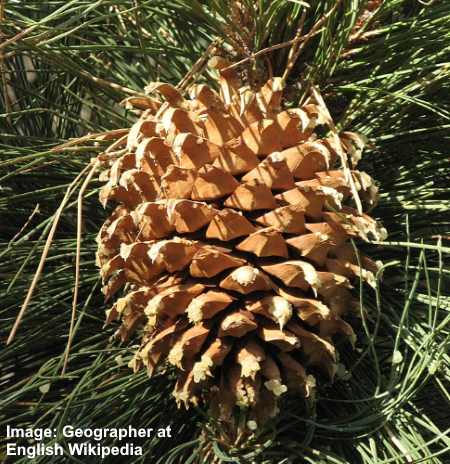
Pinus coulteri cone
This impressive coulter pine tree also grows giant, spiky cones and has the name the "big-cone pine tree." In fact, the coulter pine produces the heaviest cones of any pine tree. Its spiny pine cones can weigh between 4.4 – 11 lb. (2 – 5 kg)! This means that working near coulter pines is a definite health hazard.
The tree's fast growth rate and size mean that its wood is of poor quality for lumber.
Pine tree identification
Coulter pines grow to between 33 and 79 ft. (20 – 40 m) tall. Needles are a dull dark green color and are 6" to 12" (15 – 30 cm) in length.
Monterey Pine (Pinus radiata)
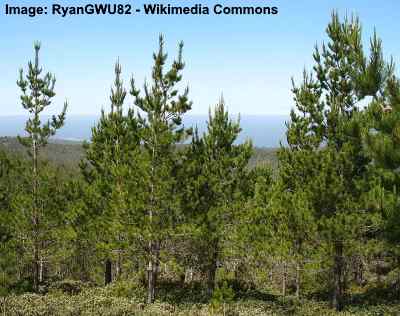
Monterey pine is identified by its branches that grow upwards
The Monterey pine tree is known for its tall stature, bright green needles, and egg-shaped cones. The pine tree is characterized by upward-pointing branches that have clusters of needles to create dense foliage.
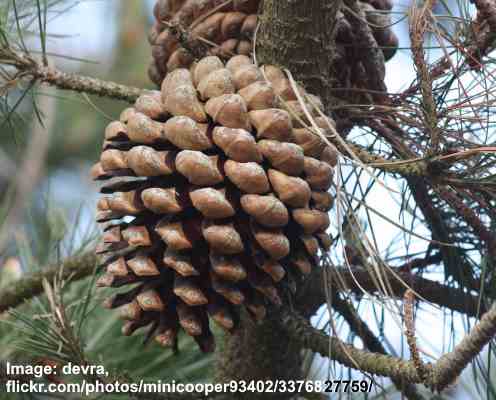
Pinus radiata cone
The Monterey pine tree needles have a blunt tip, grow in clusters of 3, and are long and slender.
Monterey pine trees are a medium-dense type of softwood conifer. This makes the species an important tree in the timber industry. High-quality Monterey pine wood products include flooring, fence posts, and indoor wooden structures.
Pine tree identification
In optimum conditions, Monterey pines can grow to 200 ft. (60 m). In coniferous forests, most species are between 50 and 100 ft. (15 – 30 m) tall. The pine is identified by needles that are 3" to 6" (8 – 15 cm) long and brown ovoid cones measuring 3" to 6" (8 – 15 cm).
Two-Needle Pinyon Pine (Pinus edulis)
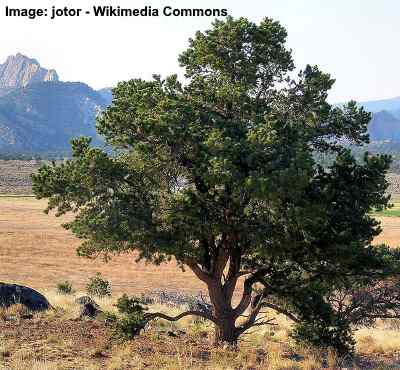
Pinyon Pine has short needles that grow in pairs
Also called the Colorado pinyon, this medium-sized bushy pine tree grows in hot or cold unforgiving climates. The wood from pinyon pines is also extremely strong despite it being classified as a "softwood."
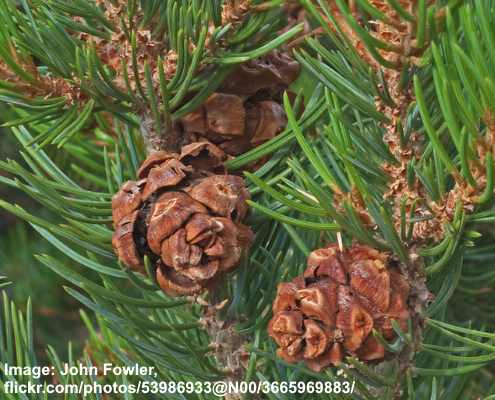
Pinus edulis cones
Needles on the brownish twigs grow in pairs and are described as "stout, long pine needles." Its branches are dense with pine needles and its bushy growth can provide shade.
Smaller varieties of pinyon pines are also sold as Christmas trees.
Pine tree identification
Pinyon pines grow to between 33 and 66 ft. (10 – 20m) and they also grow as small shrub-like trees. The oval-shaped pine cones contain edible nuts and are a yellow-tan color when mature. Needles grow in pairs (hence the name, two-needle pinyon) and are short at 2" (5 cm) long.
Whitebark Pine (Pinus albicaulis)
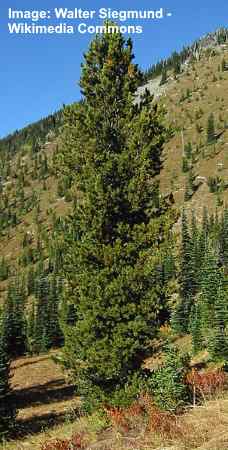
Whitebark pine usually grows on high mountains and it has pale colored bark
Whitebark pines are usually pines that grow at the highest elevations on mountains. As its common name suggests, the bark on Whitebark pine is a whitish color rather than the typical red or charcoal-gray.
Whitebark pine trees are classified in the group of white pines. It can be difficult to distinguish between the subspecies. Needles grow in clusters of 5 and the cones are long and grow to 3" (7 cm) long.
In its native habitats in the mountain forests of North America, whitebark pines are an endangered pine species.
Pine tree identification
Whitebark pines are tall trees that grow to 95 ft. (29 m) high. The dark green needles are between 1.5" and 3" (4 – 7 cm).
Pond Pine ( Pinus serotina )
Pond pine trees are medium-sized conifers with long yellowish-green needle leaves growing in bundles of three or four. The pond pine is identified by its crooked growth habit, yellow-brown cones, and dark-reddish-brown bark. As the name suggests, the pond pine grows well in poorly-drained soil, wet woodlands, and near ponds.
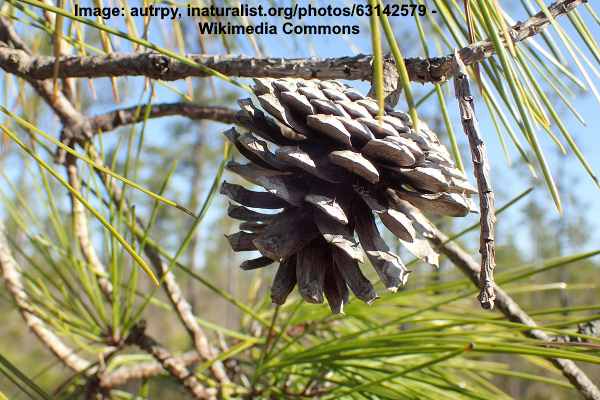
Pinus serotina cone
Pond pine trees are native southern pine trees that thrive in USDA zones 7 through 9. The evergreen conifers grow up to 70 ft. (21 m) high and perform well in most soil types.
Pine tree identification
The pond pine tree is identified by its thin, flexible pine needles with characteristic twisted tufts at the tips. The needles grow 5" to 6.5" (12 – 16 cm) long in bundles of three. Pond pine cones are small, globose cones that are yellowish-brown and have prickly scales.
Sand Pine ( Pinus Clausa )
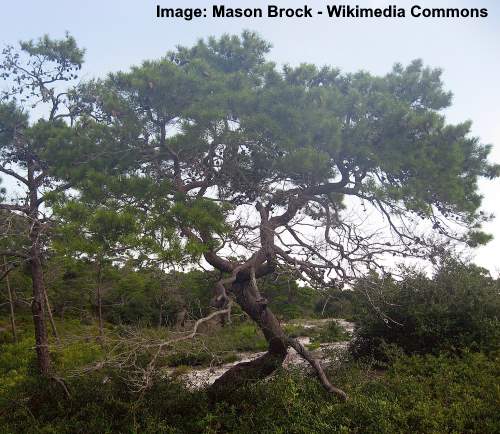
Sand pines are small and are identified by their twisted branches
The sand pine is a native coniferous tree that grows 16 to 33 ft. (5 – 10 m) tall. The pine is identified as a small to medium-sized pine tree with a spreading, conical crown and twisted branches. The pine tree's green needles and pale, brown-colored cones measure 2" to 3" (5 – 7.5 cm) long.
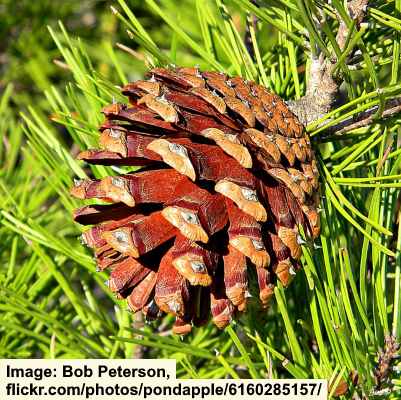
Pinus clausa cone
Sand pines are common Florida pine trees that thrive in coastal regions and are often seen growing on sand dunes. The pine trees grow best in USDA zones 9 and 10.
Pine tree identification
The sand pine is identified by its twisted branching habit, slender needles with serrated margins, and reddish-brown seed-bearing cones. Both the cones and pine needles grow 2" to 3" (5 – 7.5 cm) long.
Spruce Pine ( Pinus glabra )
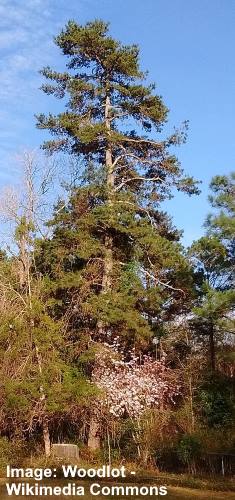
Spruce pine is native to Florida and is very tall
The spruce pine is a tall, beautiful evergreen cone-bearing tree with an oval, rounded crown. Identifying features of the spruce pine are silvery-gray needles, small cylindrical brown cones, and dark brown or gray bark. The attractive pine tree grows 80 to 115 ft. (25 – 35 m) tall.
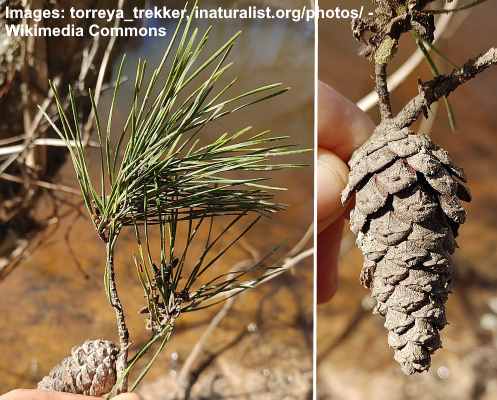
Pinus glabra needles and cone
Pine tree identification
The spruce pine tree is identified by its dark green silvery needles that grow in pairs and measure 3.5" to 4" (9 – 10 cm). Its cones are slender and relatively small, only measuring 1.5" to 3" (4 – 8 cm) in length.
Japanese Black Pine ( Pinus thunbergii )
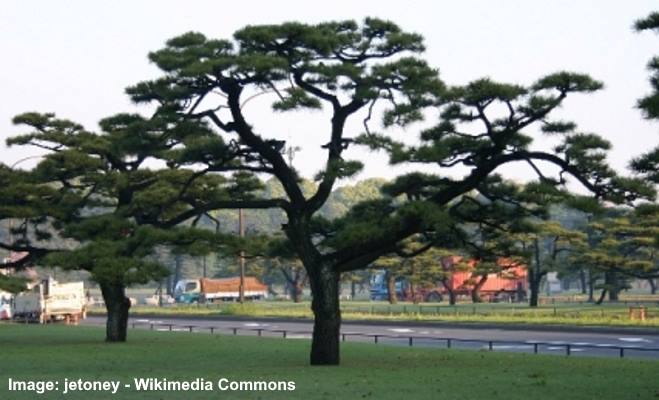
Japanese black pine is native to Japan but grows well in parts of USA
Japanese black pine is a graceful ornamental conifer tree that grows up to 130 ft. (40 m) tall. The non-native pine tree has stout and dark-green pointed needle leaves growing 3" – 4.5" (8 – 11 cm) long. The small pine cones have a conical shape and measure 1.5" (4 cm).
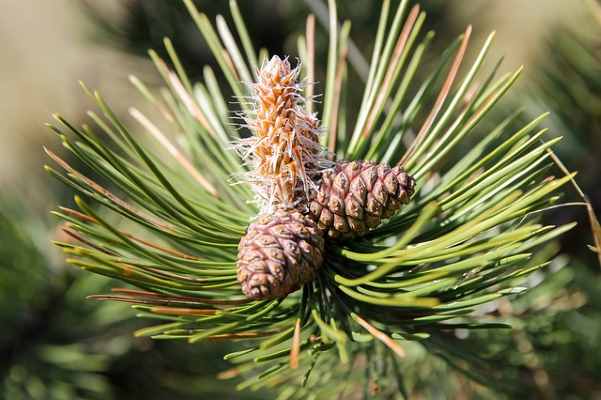
Pinus thunbergii needles and cones
Japanese black pine trees thrive in USDA zones 6 through 8. It is native to Japan and the far east. Still, it has been successfully grown in Florida and throughout the United States for many years.
Pine tree identification
The Japanese black pine is identified by its flat-topped, pyramidal habit with an irregular, spreading crown and drooping branches. The dark-green needles are stout, and the cones have a pointed egg shape appearance.
Aleppo Pine Tree (Pinus halepensis)
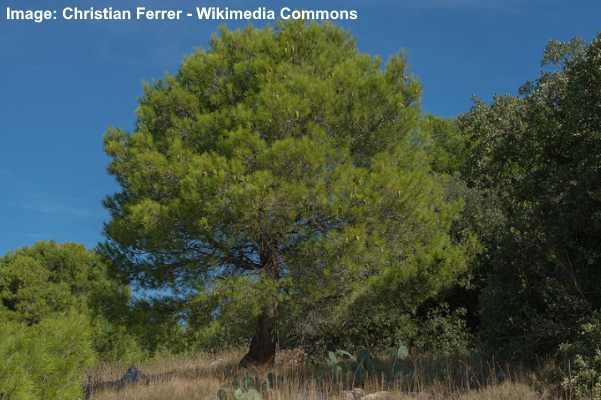
Aleppo pine tree has soft needles growing in bundles of two
The Aleppo pine tree is characterized by its narrow conical light brown cones, yellowish-green needles, and thick, orange-red bark. This pine tree is classed as a medium-sized conifer growing 50 – 80 ft. (15 – 25 m) tall. Aleppo pine needles are soft and slender, measuring 2.3" to 4.7" (6 – 12 cm) long and growing in bundles of two.
Aleppo pine trees are native to the Mediterranean region and are also called the Jerusalem pine. In a landscape, the heat-loving, sun-tolerant pine has a flat-topped crown with an irregular branching pattern. Additionally, the pine can be identified by its thick, deeply fissured bark at the trunk's base.
Although native to the Mediterranean, Aleppo pine trees commonly grow in California. They are hardy to USDA zone 8.
Pine tree identification
The Aleppo pine tree is identified as a two-needled pine that grows to a medium height and produces slender brown cones measuring 2" to 4.7" (5 – 12 cm) long.
Austrian Pine Tree (Pinus nigra)
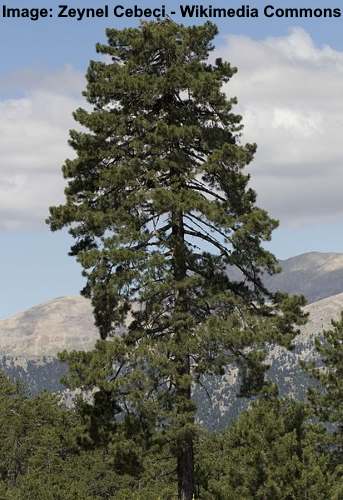
The Austrian pine tree is identified by its hard needles growing in bundles of two
Also called the European black pine, the Austrian pine tree is a medium to large coniferous tree growing 66 to 180 ft. (20 – 55 m) tall. The identifying features of the pine tree are its grayish-brown bark, conical seed cones measuring 2" to 4" (5 – 10 cm), and long stiff needles growing in bundles of two.
The Austrian pine is classified as a hard-needled pine with rapid growth. The mature pine has a long, straight, slender trunk with a conical, slightly rounded crown. In time, the pine tree's canopy develops an irregular shape.
Pine tree identification
The Austrian pine tree is characterized by its gray bark with deep fissures and ridges, buff-colored pine cones with rounded scales, and hard needles growing in pairs.
Foxtail Pine Tree (Pinus balfouriana)
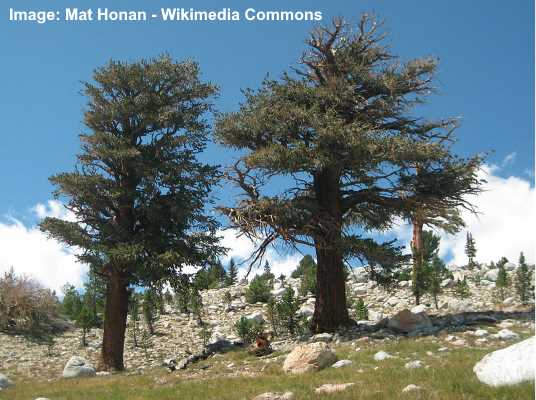
Foxtail pine tree is a five needle conifer which usually grows in higher altitudes
The foxtail pine tree is a medium-sized conifer with a thick trunk and broad, irregular crown. Native to California, this pine tree has curved green needles growing in bundles of five, dark red-brown seed cones, and bark that is reddish or cinnamon in color with deep, irregular fissures.
The foxtail pine grows up to 30 to 70 ft. (10 – 20 m) tall. The stout pines with their broad trunk are typically found growing in higher elevations in subalpine forests.
Pine tree identification
The foxtail pine is a five-needle conifer species, identified by its deeply fissured reddish bark, cylindric or egg-shaped cones that turn from purple to reddish-brown, and small needle leaves growing 1" to 1.5" (2 – 4 cm) long.
Italian Stone Pine Tree (Pinus Pinea)
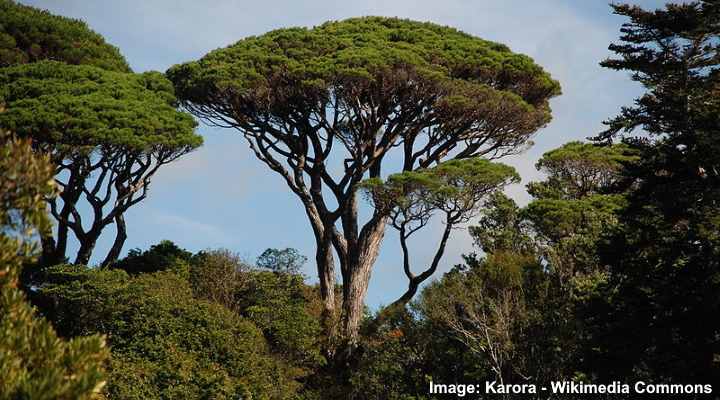
Italian stone pine tree has a distinctive canopy shape and is also called the umbrella pine
The Italian stone pine tree is an easily identifiable pine tree due to its spreading umbrella-like canopy. Features of the distinctive pine include broad, ovoid brown cones measuring 3" to 6" (8 – 15 cm) long, glaucous blue-green needles 0.75" to 1.5" (2 – 4 cm) long, and thick reddish-brown bark.
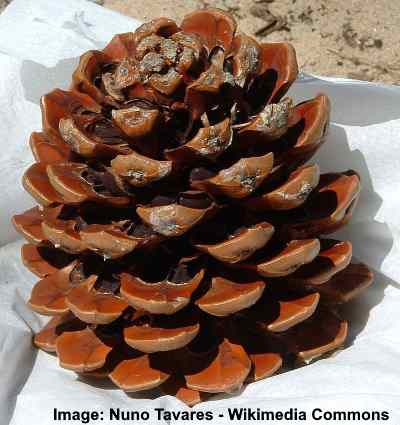
Pinus pinea cone
The Italian stone pine is a characteristic feature of Mediterranean landscapes. The tall, majestic tree with its spreading crown, has a distinct Y shape.
Also called the umbrella pine or parasol pine, the two-needled pine tree grows up to 80 ft. (25 m) tall. Unlike other pines that live for hundreds, even thousands of years, the Italian stone pine has a relatively short life—only 150 years.
Pine tree identification
The easy-to-identify Italian stone pine has a distinctive appearance of an umbrella. Identifiable features of the Italian stone pine are its orange-red bark, hard, green needles growing in pairs, and broadly ovoid shiny brown seed cones.
Jeffrey Pine Tree (Pinus jeffreyi)
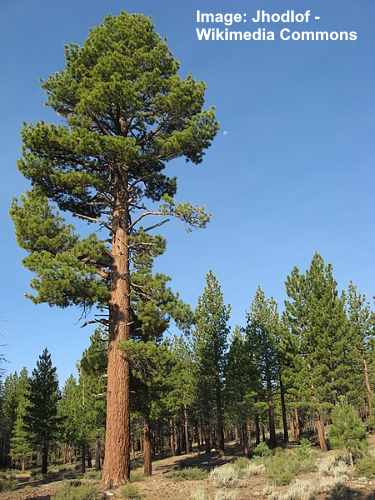
The tall Jeffrey pine is a three-needled pine tree with scented bark and smooth cones
Also called the yellow pine or black pine, the Jeffrey pine tree is a tall, native coniferous evergreen growing 82 to 130 ft. (25 – 40 m) tall. The yellow pine species has distinctive prickly gray-green needle leaves growing 4.7" to 9" (12 – 23 cm) long. The pine cones emerge purple before turning pale brown and grow as long as the needles—up to 9" (23 cm) long.
Jeffrey pine trees belong to the three-needled pine subgroup. The tall, erect pine tree is recognized in the landscape by its brown bark, conical crown, and cones that feel remarkably smooth.
Another feature to help identify the Jeffrey pine tree is the sweet scent the needles and bark emit. Try rolling the stout needles in your hand or break off some bark to detect lemon, vanilla, apple, or even butterscotch aromas.
Pine tree identification
To identify the Jeffrey pine tree in a landscape, look for pale green needles growing in bundles of three, long slender pale brown smooth cones and brown bark that gives off sweet fragrances.
Limber Pine Tree (Pinus flexilis)
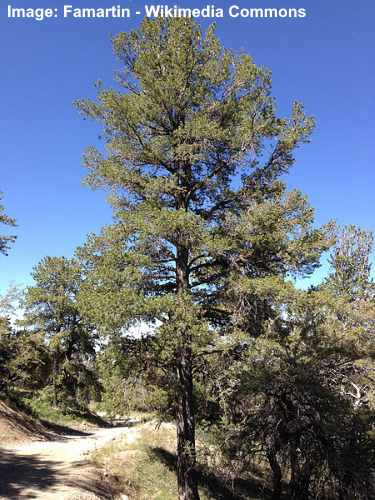
Limber pine is a type of white pine with soft needles growing in bundles of five
The limber pine is a native species of white pine with a conical, contorted crown, light gray bark, dark green needles, and tan-colored ovoid cones. The limber pine is a species of five-needled, soft pine tree. Its bluish-green needles measure 3" (8 cm) long, and its cones measure 2.7" to 6" (7 – 15 cm) long.
Limber pine trees grow around 65 ft. (20 m) tall. However, in higher elevations where the pine is commonly found, it may only reach 15 – 35 ft. (5 – 10 m) tall.
The botanical name and common name for limber pine come from the unique characteristic of the tree's branches. Its branches are incredibly flexible and difficult to break. Therefore, you may see the tree's foliage drooping heavily under the weight of snow.
Pine tree identification
The limber pine tree is identified by its smooth, light-gray, sometimes dark bark, reddish-brown twigs, 5-needled fascicles, and cylindric pale red to yellowish-red cones.
Mugo Pine Tree (Pinus mugo)
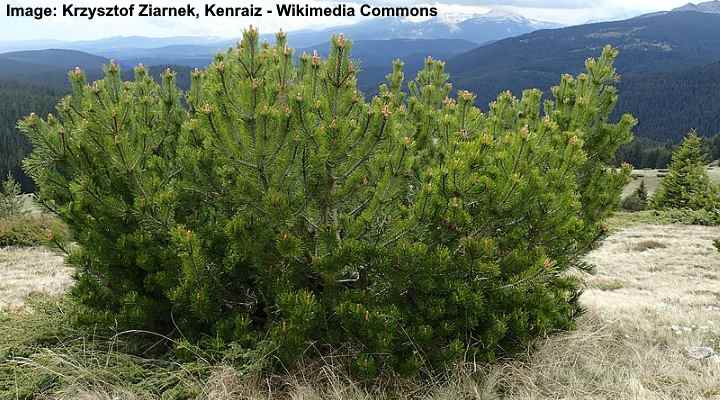
Mugo pine is a small shrubby tree with 2-needled fascicles that is suitable for landscaping compact spaces
The mugo pine is a small coniferous tree or shrub commonly used to landscape evergreen gardens. The ornamental pine tree grows 3 to 10 ft. (1 – 3 m) tall. The two-needled pine has dark green leaves growing 1.1" to 2.7" (3 – 7 cm) long, and small nut-brown cones measuring up to 2.1" (5.5 cm) long.
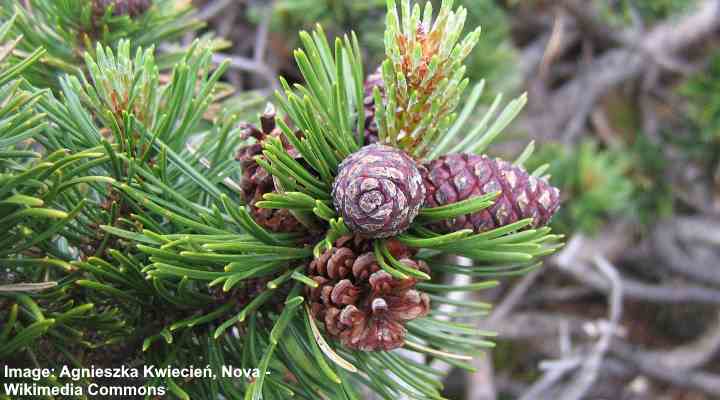
Pinus mugo needles and cones
Other names for the mugo pine include creeping pine, dwarf mountain pine, Swiss mountain pine, and bog pine.
Pine tree identification
The mugo pine is easy to recognize due to its short stature, dark green needle leaves growing in pairs, and small pyramidal cones.
Maritime Pine Tree (Pinus pinaster)
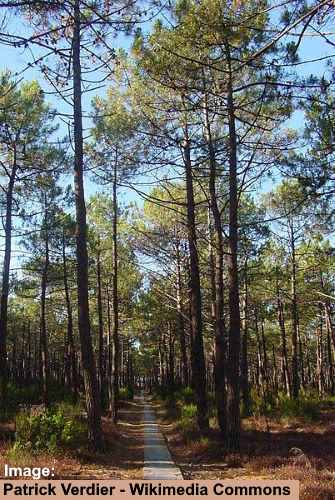
The maritime pine is a two-needled pine tree with a slender and straight trunk
Also called the cluster pine, the maritime pine is a fast-growing, medium-sized pine tree that grows 66 – 115 ft. (20 – 35 m) high. The pine tree features a slender, upright trunk and a relatively small pyramidal crown. Distinguishing features of the maritime pine are long yellowish-green stiff needles and conical cones growing 4" to 8" (10 – 20 cm) long.
The maritime pine is a species of European pine. These conifers are two-needled pine trees. The unique feature of the maritime pine is that its needles are the most robust of all the European pine trees.
Pine tree identification
The maritime pine tree is identified by its thick, orange-red bark with deep fissuring at the base. The yellowish-green needles measure 10" (25 cm) long and grow bundled in pairs.
Mexican Weeping Pine Tree (Pinus patula)
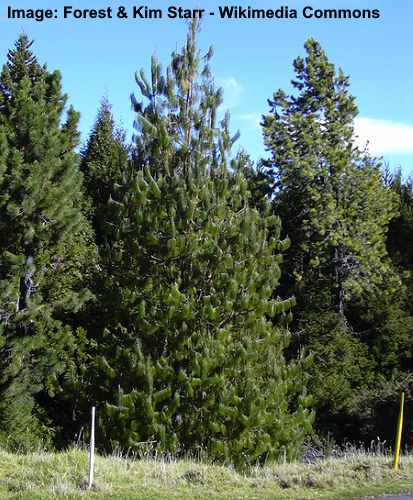
The Mexican weeping pine tree has drooping long needles which are bundled in groups of 3 to 5
The pyramidal Mexican weeping pine is a tall, robust pine tree growing 131 ft. (40 m) tall. This pine has slender branches covering the length of its reddish-brown scaly trunk. Tufts of drooping pine needles grow three to five in a fascicle and measure up to 12" (30 cm) long.
The Mexican weeping pine is easy to recognize in the landscape. Distinctive features include thin, weeping needle leaves, long dark brown conical cones that are slightly bent, and scaly red bark that becomes fissured and gray with age.
Pine tree identification
The identifying characteristics of the Mexican weeping pine are its curved seed cones, long arching needle-like leaves, and distinctive habit of branches covering the trunk's length.
Lacebark Pine Tree (Pinus bungeana)
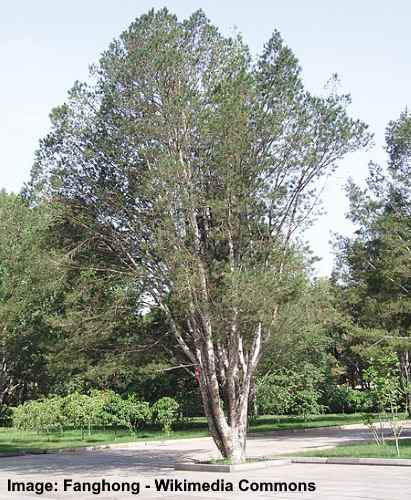
Lacebark pine is a multi stemmed tree with 3 needled fascicles and attractive colorful bark
The lacebark pine tree is an unusual conifer due to its distinctive mottled white, gray, and red bark. And unlike most pine trees, this sun-loving pine is a multi-stemmed tree. The pine tree features stiff pointed needles growing three to a fascicle, yellowish-brown oval cones, and creamy-white patchwork bark.
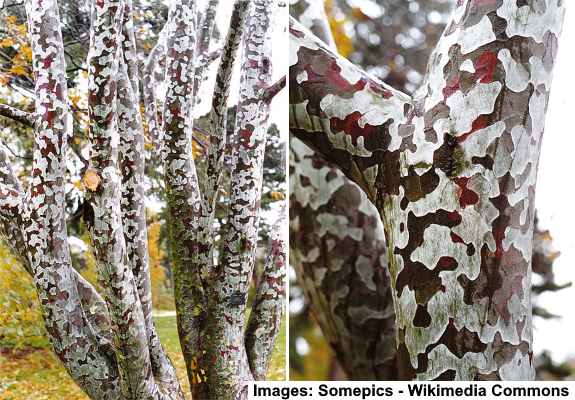
Pinus bungeana bark
The ornamental lacebark pine tree grows 30 – 50 ft. (9 – 15 m) tall and thrives in USDA zones 4 to 8. The pine is prized for its decorative value, adding all-year interest due to its attractive metallic bark, long green needles 2" to 4" (5 – 10 cm) long, and elegant shape.
Pine tree identification
The lacebark pine tree is a three needled pine identified by its smooth, colorful bark, long stiff needles, turpentine aroma from crushed foliage, and small egg-shaped brown cones.
Single-Leaf Pinyon Pine Tree (Pinus monophylla)
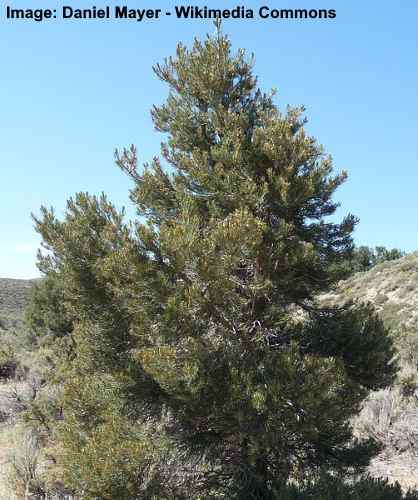
The single-leaf pinyon pine tree has only one needle per fascicle
The single-leaf pinyon pine is a medium-sized conifer with thick pine needles, globose light brown cones, and scaly brown bark. The unique characteristic of the Pinus monophylla is its single needle leaf in each fascicle. The single-leaf pinyon pine is native to the western United States and grows 33 to 66 ft. (10 – 20 m) tall.
Pine tree identification
The single-leaf pinyon pine is identified by its glaucous blue-green needles growing 1.5" to 2.3" (4 – 6 cm) long, globose cones 3.1" (8 cm) long, and scaly bark with irregular furrows. You can tell this pine tree apart from other pines because each fascicle contains a single needle.
Great Basin Bristlecone Pine Tree (Pinus longaeva)
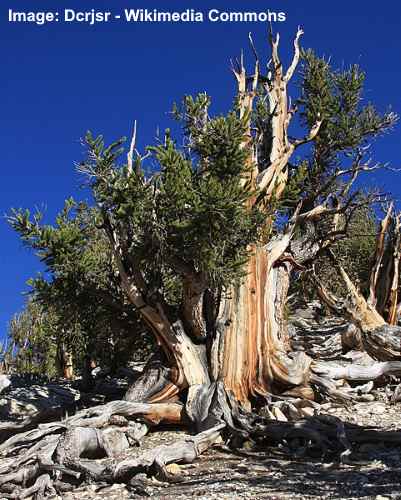
The great basin bristlecone pine is a 5-needled medium sized long living tree
The great basin bristlecone pine tree is a medium-sized conifer with a colossal trunk covered in bright orange-yellow bark. The long-living pine tree needles are deep green and grow 1" to 1.5" (2.4 – 4 cm) long. The large egg-shaped cones measure 2" to 4" (5 – 10 cm).
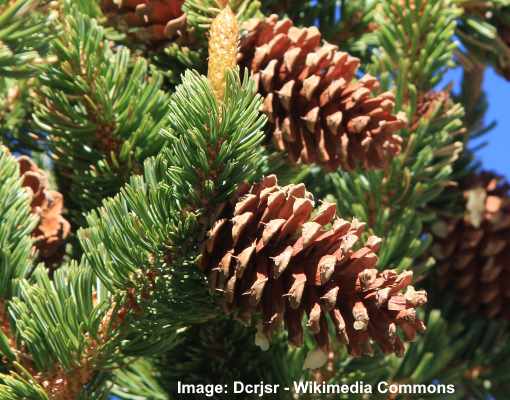
Pinus longaeva cones and needles
The bristlecone pine tree is one of the longest-living pines in the mountains of western United States. The pine tree grows 16 to 50 ft. (5 – 15 m) tall and is characterized by contorted branches. Needle-like evergreen leaves on the tree can persist for up to 43 years.
Pine tree identification
The identifying features of the five-needled, great basin bristlecone pine are its bristly ovoid cones, deep green needles featuring a white band, and its broad trunk measuring up to 12 ft. (3.6 m) in diameter.
Japanese Red Pine Tree (Pinus densiflora)
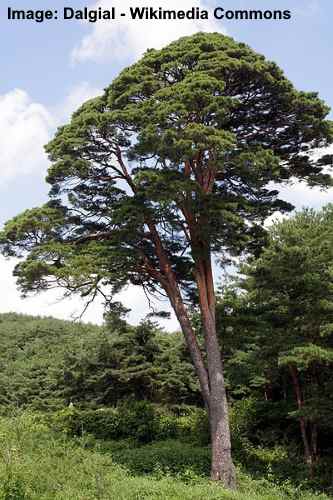
The Japanese red pine is a two-needled pine tree with flaky reddish-brown bark
The Japanese red pine is a tall, majestic pine tree with an open, umbrella-shaped canopy, red-brown bark, and long needle leaves. This red pine species is a two-needle pine tree, with two 3" (7.5 cm) leaves growing in each fascicle. The slender, erect pine tree grows 66 to 115 ft. (20 – 35 m) tall.
In appearance, the Japanese red pine resembles the Scots pine tree. The difference between the two is that the Japanese red pine has longer, slenderer leaves that are more green than glaucous blue.
Pine tree identification
The Japanese red pine tree is identified by its two dark green needles in each bundle, conical golden brown seed cones, and reddish-brown bark forming flaky, papery plates.
Related articles:
- Small or Dwarf Evergreen Trees For Your Garden
- Types of Fir Trees with Identification Guide and Pictures
- Types of Flowering Trees with Pictures for Easy Identification
Read Next
Source: https://leafyplace.com/types-of-pine-trees-identification-and-pictures/
0 Response to "How to Draw Tall Pine Trees"
Post a Comment